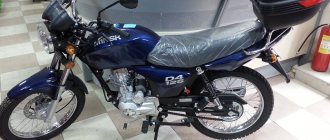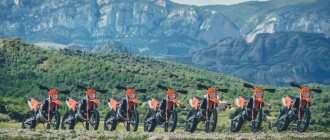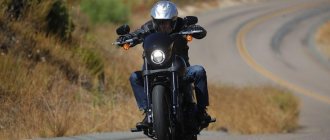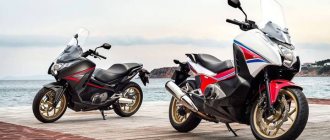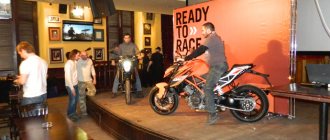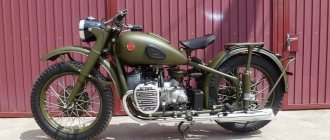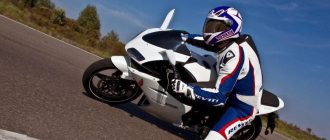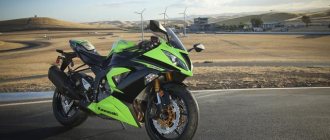Gibbs Technologies began operations in 1996, having moved from New Zealand to the USA and then to the UK. Today it is the most influential company in the world in the development and production of high-speed amphibians. This is the sole owner of the HSA (High Speed Amphibian) technology, thanks to which the unique Gibbs Quadski amphibious ATVs are produced today. The first model was developed in 2008, and it went into mass production in 2012. These are unique vehicles, the likes of which have never existed before.
Advantages of water ATVs:
- The device combines all the best qualities of an ATV, aquabike and a jet ski.
- The maximum speed of the vehicle is 72 km/h on land and water.
- Transformation from an ATV to a jet ski takes 5-7 seconds. at the press of just one button. At the same time, the wheels rise up, providing high-quality gliding along the water surface.
- The powerful, liquid-cooled, four-stroke, four-cylinder, motorcycle-type engine of the BMW Motorrad K1300 features a jet ski-like jet.
- Light metal is used in production, which provides a fairly large floating ATV with maneuverability and good controllability.
- The design is completely sealed, which allows you to do dives and other tricks on the water. The ATV is also not afraid of rollovers, which makes it no less functional than a jet ski.
- There is a built-in protection system that uses sensors to determine whether the ATV is on water or land. The system also has a built-in throttle position and speed sensor.
- The design and all systems are thought out to the smallest detail. If the ATV is traveling over rough terrain and a large boulder hits its bottom, the bottom will not break through. A special plastic patented by the company, which is both durable and elastic, is responsible for this.
- Liquid from the tank is supplied under pressure, cleaning important systems from dirt.
Today, all extreme riding enthusiasts know about ATVs for water and off-road use. The first Gibbs Quadski development broke the record for amphibians, managing to cross the English Channel in 2 hours.
Model Quadski-1
Gibbs Technologies currently produces two models of amphibious ATVs. Quadski-1 is a lightweight version with a seat designed for one person. Two people can ride on the Quadski XL. The features of the single-seat amphibious ATV are as follows:
- BMW engine, four-stroke injection, four-cylinder.
- Engine capacity – 1293 cc. cm.
- Power – 140 hp
- Cooling is liquid.
- Brakes are hydraulic.
- Load capacity – 120 kg.
- Gas tank – 57 l.
- Control - one steering lever and trigger-type gas.
- Gearbox – 5-speed, electromechanical.
- A water cannon is an attachment combined with the main motor.
- Passenger capacity – 1 person.
- Track width – 1.41 m.
- Width – 1.58 m.
- Length – 3.26 m.
- Height – 1.36 m.
- Ground clearance – 2.25 m.
- Wheelbase - 1.79 m.
- Weight – 605 kg.
The ATV consumes 6.3 liters of gasoline (AI-92) in the combined cycle, and when driving in the city or water - 7.5 liters per 100 km.
First test of the Gibbs Quadski
A surprisingly well-handled, agile on the water, but impractical amphibian.
It is very difficult to imagine anyone who would turn down the opportunity to ride a Gibbs Quadski. After all, it is a hybrid of an ATV and a jet ski! This is an all-terrain vehicle that, at the press of one button, allows the owner to feel like a child and a movie hero. With the help of unknown forces, you will move from land to sea, dealing with imaginary Decepticons and riding off into the sunset with Megan Fox. Okay, it's not as cool as fighting robots from outer space, and the single seat design will force you to leave Miss Fox on the shore, but driving a Quadski is a unique and unforgettable experience.
Powered by a BMW K1300 motorcycle engine with an impressive 175 horsepower and 140 Newton meters of torque, the 600-kilogram Quadski accelerates to a top speed of 72 kilometers per hour. Power is sent to the rear wheels through a six-speed automated manual transmission controlled by steering wheel buttons. The BMW engine is undoubtedly capable of developing more
faster, and we expected more from BMW in the world of ATVs and all-terrain vehicles, but Gibbs' decision to keep the amphibian's top speed under 50 mph is understandable. The machine is heavy, the composite hull is relatively fragile, and a malfunction could lead to a big problem on the water.
The machine's low center of gravity and 1,471mm width make it surprisingly comfortable and capable on ATV trails, but the lack of all-wheel drive gives it some serious consideration. Most two-wheel drive ATVs have trouble in the soft, slippery mud found on most shorelines, so the Gibbs Quadski needs to generate quite a bit of speed when moving in and out of the water.
The Quadski body is strong, reliable, lightweight and made from a single piece using modern composite technology. The transformation from ATV to jet ski is surprisingly smooth with the push of a button next to the ignition switch, which then extends or retracts the wheels and transfers the BMW engine's power output to the drive shaft or jet. The only thing that gives the car away as an amphibian on the water is the front tires that peek above the body. The rear tires slide flat and sit discreetly underwater. On the water, the Gibbs Quadski is a lot of fun to drive. This is a maneuverable and sharp-launching car, but in theory it should accommodate at least one passenger and allow wakeboarding or water skiing.
Any final words? Riding the Quadski on light off-road terrain and quickly switching to jet ski mode is incredibly fun and cool, but it doesn't come without compromises. This is an outrageously expensive machine (in the US the model costs almost 40 thousand dollars), which, unfortunately, will never be reliable as an ATV or agile as a jet ski. Until the price comes down, the Quadski will likely only be seen aboard extravagant and expensive yachts.
Gibbs Quadski Specification |
| Engine |
| Type: 4-cylinder 16-valve DOHC |
| Volume: 1293 cubic meters cm. |
| Bore X Stroke: 80.0 mm. X 64.3 mm. |
| Cooling: Closed loop system (ground); closed and open circuit heat exchangers (on water) |
| Fuel system: Electronic fuel injection system |
| Starter: electric starter |
| Transmission |
| Drive System: RWD Shaft/Gibbs Jet |
| Gearbox: Sequential, electronically controlled and centrifugal clutch, electronic reverse (on ground) |
| Hull and drive on water |
| Hull: monocoque double-layer composite |
| Impeller: 5-blade stainless steel |
| Stator: 11-blade cast aluminum |
| Suspension (type) |
| Front: Independent with coil springs and hydraulic shock absorbers |
| Rear: Independent with coil springs and hydraulic shock absorbers |
| Tires/Wheels |
| Front: CST/25×8-12 |
| Rear: CST/25×8-12 |
| Brakes |
| Front: Dual hydraulic discs (ground) |
| Rear: Dual hydraulic discs (ground) |
| Dimensions |
| Wheelbase: 11767 mm. |
| Claimed dry weight: 604 kg. |
| Ground clearance: 228 mm. |
| Length/width/height: 3200 mm. / 1585 mm. / 1310 mm. |
| Tank capacity: 56.7 l. |
| Load capacity |
| Payload: Up to 118 kg. (place for a helmet under the seat) |
| Electrics |
| Light: Two HID headlights |
| Instrument panel: Speedometer, odometer, fuel level indicator, engine temperature indicator, clock |
| Colors: Blue, red, yellow, orange, black |
Model Quadski XL
The Quadski XL ATV has increased dimensions and can carry 2 passengers. The characteristics of this vehicle are as follows:
- Engine – BMW, four-stroke injection, four-cylinder.
- Engine capacity – 1293 cc. cm.
- Power – 140 l. With.
- Cooling is liquid.
- Brakes - hydraulic.
- Load capacity – 185 kg.
- Gas tank – 57 l.
- Control - one steering lever and trigger-type gas.
- Gearbox – 5-speed, electromechanical.
- A water cannon is an attachment combined with the main motor.
- Passenger capacity – 2 people.
- Track width – 1.41 m.
- Width – 1.58 m.
- Length – 3.56 m.
- Height – 1.34 m.
- Ground clearance – 2.15 m.
- Wheelbase - 2.09 m.
- Weight – 652 kg.
Gibbs Quadski amphibious ATVs and their operation
Quadski ATVs are equipped with independent suspension, and torque is transmitted to all 4 wheels. If desired, by pressing a button, the front axle can be turned off. Both axles have differentials, so this vehicle can even be driven on asphalt.
The motor is quite economical when driving on land. A full gas tank of the ATV is enough for about 600 km over rough terrain. The versatility of the vehicle opens up great prospects for its use in rescue or military operations, and not just for leisure.
The throttle trigger is located, as on all land ATVs, under the thumb on the right. On jet skis it is located under the index finger. The ATV accelerates quickly, which is immediately reported by the howling gearbox. To control it, when the speed increases, you need to switch the key manually (located on the left). When the speed decreases, the reset to lower stages occurs automatically.
On land, engine power is limited to 45 hp. With. This is enough to easily accelerate to a top speed of 72 km/h. The ATV enters a fast turn with confidence, but you need to hang down to stay in the saddle. If you ride relatively slowly, you can sit in the saddle.
To perform the reverse function, the system has a separate electric motor. It works exclusively in reverse, allowing you to drive backwards within 10 seconds. The system then turns off, requiring recharging from the standard battery.
Catalog
This hydro ATV is capable of not only overcoming water obstacles, but also giving riders incredible pleasure. The amphibian accelerates through water at a speed of 72 km/h! Quite a normal speed to get a dose of adrenaline by dashing into turns on the water surface. On the ground, the Quadski also reaches speeds of up to 72 km/h. The main highlight of the Quadski is that when you press a “specially trained button,” the wheels of this amphibious amphibian fold, driving inside the wheel arches, and do not interfere at all with gliding across the expanses of water. The procedure for turning an all-terrain vehicle into a jet ski (and back) takes about 5 seconds. The 140-horsepower 4-cylinder liquid-cooled gasoline engine has a water jet (exactly like on a jet ski), which comes into operation after pressing the button that folds the wheels. Quadski is completely sealed and is not afraid of flips on the water, so you can do tricks and all kinds of dives no worse than on a regular aquabike. The Quadski amphibian is foolproof. Installed sensors (speed, throttle position and a sensor that tracks where the Quadski is: on land or in water) eliminate the possibility of doing anything stupid and releasing the chassis on the water or, on the contrary, removing them on the road, which means breaking this technically complex device. The Quadski amphibian is thought out to the smallest detail. If you are driving across a field and do not notice a cobblestone lying in your way, the bottom of the amphibian will not burst, because the special patented plastic composition has good strength and at the same time elasticity. Half a minute ago you were kneading mud, and now you decided to swim. Clods of earth stuck to the suction hole of the pump can instantly destroy, if not the engine, then the water cannon itself. To avoid any accident, the Quadski has a water tank. Liquid from the reservoir under pressure clears dirt from the channels vital to the pump. A little about the Quadski's overland characteristics.
The 4-cylinder power unit with a displacement of 1.6 liters produces 140 “horses” already at 3500 rpm. At the same time, the engine on land is quite economical: a 50-liter tank is enough for 600 kilometers of cross-country driving. Fuel consumption on water is not so gentle - a full tank lasts for a couple of hours. When the water jet is turned on, the “brains” that control the operation of the injection engine begin to prepare a different fuel mixture. As a result, the engine produces maximum power already at 7000 rpm. The Quadski's suspension is completely independent. The levers are made of forged aluminum (as is the supporting frame), making the amphibian very light (583 kg). In the civilian version of the Quadski, torque can be transmitted to all four wheels (by pressing a button you can connect or, on the contrary, disconnect the front axle), while both axles have differentials, so this amazing amphibian can even be driven on asphalt. The Quadski version for rescuers and the military is somewhat different, because the rear axle does not have a differential. But for extreme off-road driving on the military version of the Quadski, you can lock the center differential and the front axle differential. Yes, it’s difficult to steer, but at least you can get to the end of the world. The Quadski is a practical and incredibly exciting vehicle, says founder and owner of Gibbs Technologies Ltd. A native of New Zealand, Alan Gibbs. “Our Quadski can be a great leisure vehicle, but it can also be useful for rescuers and the military, for whom the versatility of a vehicle is always a plus.
*It is possible to order the ATV in any color, delivery time is 3-5 days. Or pasting with high-quality car film. Available in Red Apple color (as of 09/10/2014)
Walking on water
The amphibian maintains its speed even when moving through water. But fuel consumption in this mode increases noticeably. So, a full tank when driving on a water surface will be completely used up in just 2 hours. This is due to the presence of intelligent system control. When the water jet is turned on, the injection mechanism begins to prepare a different fuel mixture. Thanks to this feature, the engine reaches maximum power already at 7000 rpm.
A special feature of this amphibian is its tightness, which allows you to dive under water and perform various exciting stunts. Even if the vehicle overturns, it will not sink, which increases driving safety in any conditions.


